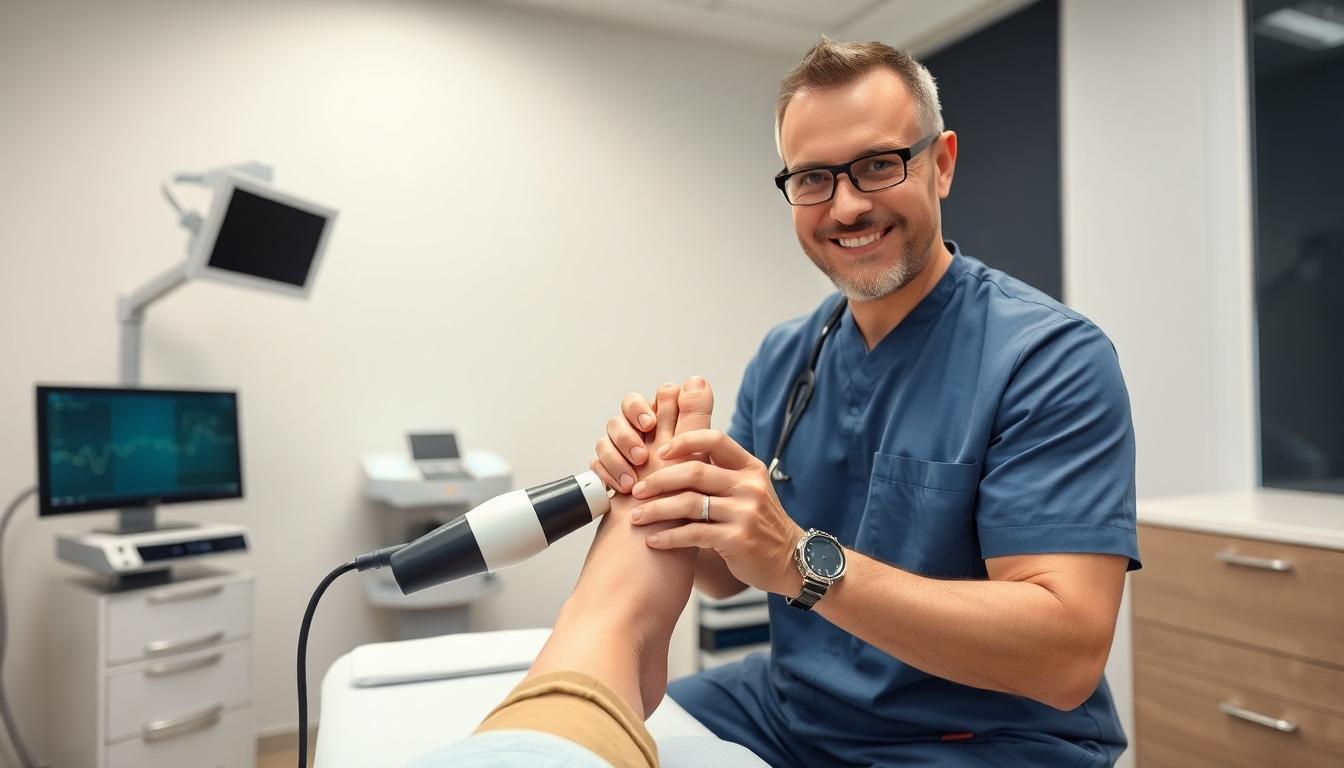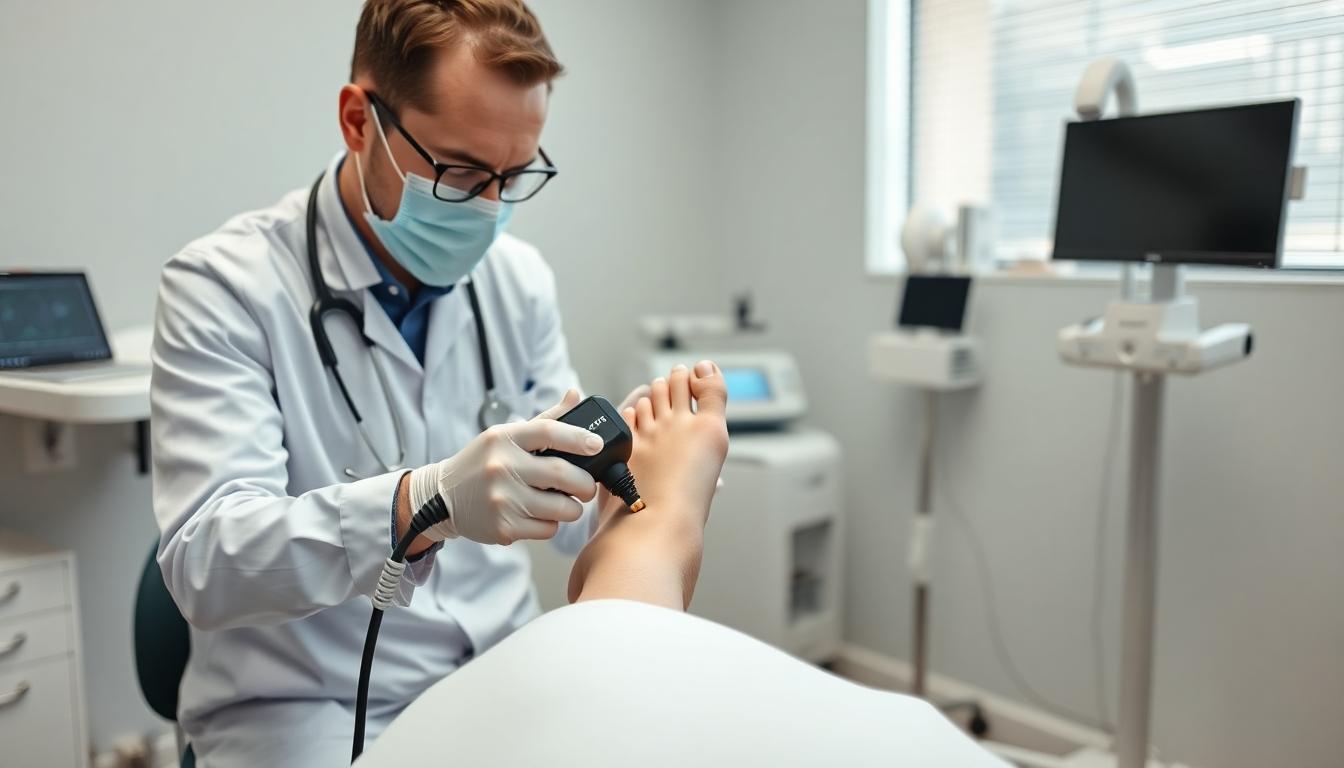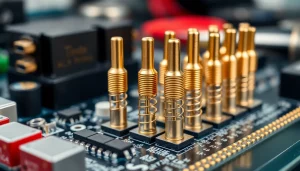
Does Shockwave Therapy Hurt? What to Expect During Treatment and Pain Levels Explained
Key Takeaways
- Shockwave therapy is a non-invasive treatment commonly used for foot and ankle conditions like plantar fasciitis and tendonitis, utilising sound waves to promote tissue healing and pain relief.
- Most patients experience mild to moderate discomfort during shockwave therapy, typically described as a tapping or pulsating sensation, which is managed and monitored by clinicians for optimal comfort.
- Temporary soreness or increased sensitivity may occur after treatment but usually subsides within 24–48 hours, allowing most patients to resume light activities shortly thereafter.
- The level of discomfort can be influenced by factors such as treatment intensity, injury location, and individual pain tolerance, with clinicians able to adjust settings for sensitive patients.
- Shockwave therapy provides a safe alternative to surgical interventions and medications, with fewer risks and faster recovery for chronic pain sufferers.
- Not everyone is suitable for shockwave therapy—patients with certain medical conditions (such as pregnancy, bleeding disorders, or tumours near the treatment site) should seek professional assessment before undergoing treatment.
Many people considering shockwave therapy wonder if the treatment will be painful. This non-invasive procedure uses sound waves to target areas of pain or injury and is often recommended for conditions like plantar fasciitis or tendonitis. Understanding what to expect during a session can help ease nerves and allow patients to make informed decisions about their care.
Understanding Shockwave Therapy
Shockwave therapy uses high-energy sound waves to treat musculoskeletal pain and speed up soft tissue healing. Podiatrists at Align HC – Podiatrist Indooroopilly frequently use this treatment for persistent foot problems, such as plantar fasciitis, Achilles tendinopathy, and sports-related injuries. During a session, the podiatrist applies a specialised device to the affected area, where sound waves pass through skin and target damaged tissues.
Sessions usually last 10–20 minutes, depending on injury severity and treatment site. Align HC – Podiatrist Indooroopilly creates individual plans, so the number of sessions varies based on patient progress and injury type. Patients often notice changes in pain or mobility after 1–3 sessions.
Shockwave therapy appeals to those seeking non-surgical options for chronic pain in areas like the foot, heel, and ankle. Most sports medicine specialists, including Chalerm Tuantab at Align HC, use clinical protocols that have demonstrated safety and effectiveness according to Australian Podiatry Association guidelines. For more details about appointments at Align HC, patients can contact 07 2103 3978 or [email protected] or visit 1/49 Station Rd, Indooroopilly QLD 4068.
How Shockwave Therapy Works

Shockwave therapy uses acoustic sound waves to aid tissue repair and manage pain in the foot and ankle. Align HC – Podiatrist Indooroopilly applies this technology to treat both acute and chronic foot injuries safely and efficiently.
The Science Behind The Treatment
Shockwave therapy delivers radial sound waves through a handheld device placed on the skin. These waves pass into the affected area using ultrasound gel to improve contact. In targeted tissues such as tendons or ligaments, the sound energy produces controlled microtrauma. Cells in the treated area then increase their regenerative activity, producing more collagen and supporting tissue healing. This process boosts blood flow and helps break down adhesions or scar tissue while also reducing chronic pain. Most patients at Align HC report sensations like tingling or mild discomfort during treatment; these effects usually subside soon after the session.
Common Conditions Treated
Podiatrists at Align HC – Podiatrist Indooroopilly use shockwave therapy for sports-related foot and ankle injuries. Treated conditions include plantar fasciitis, Achilles tendinopathy, and stress fractures. The therapy also supports healing in tendonitis, osteoarthritis, and nerve entrapment syndromes. Patients often experience improved mobility and pain relief after 1–3 sessions. Each protocol at Align HC is tailored to injury severity and patient activity level, with sessions generally lasting 10–20 minutes. Anyone with persistent pain or slow-to-heal injuries can book an assessment at the Indooroopilly clinic by phone on 07 2103 3978 or via www.alignhc.com.au.
What To Expect During A Shockwave Therapy Session
Patients attending Align HC – Podiatrist Indooroopilly for shockwave therapy can anticipate a straightforward session designed to maximise comfort and treatment effectiveness. Therapy sessions are conducted by experienced clinicians, and most treatments last between 10 and 20 minutes.
The Procedure Step-By-Step
- Preparation: Clinicians typically position patients so the targeted foot, ankle, or heel area is exposed and supported.
- Application of Gel: A conductive gel is applied to the area to ensure efficient delivery of sound waves to the underlying soft tissue.
- Shockwave Application: The shockwave therapy device is placed directly over the identified injury site, with controlled pulses delivered to encourage tissue repair and reduce pain.
- Align HC podiatrists routinely monitor patient comfort and adjust intensity levels if required, with real-time feedback from the patient. Appointments occur at 1/49 Station Rd, Indooroopilly, QLD.
Sensations Typically Experienced
- Initial Sensations: Most describe the beginning of treatment as pressure or a light tapping sensation—some liken it to a gentle massage.
- Intensity Shifts: Discomfort may increase as the intensity grows, particularly with chronic heel or tendon injuries. Some patients experience sensations similar to a deep massage or slight pain.
- After Effects: Temporary soreness often follows, similar to muscles after strenuous exercise; this usually subsides within 24–48 hours.
- Sensitivity differs among individuals, but pain levels are monitored to remain tolerable.
- Immediate relief or improved mobility occurs for many; however, the biological healing process continues over several weeks (Australian Podiatry Association, 2024).
- Questions about comfort, session protocols, or custom care can be directed to Align HC at 07 2103 3978 or [email protected].
Does Shockwave Therapy Hurt?
Shockwave therapy, used at Align HC – Podiatrist Indooroopilly, delivers sound waves to treat musculoskeletal pain. Patients often ask if the treatment causes pain or significant discomfort.
Patient Perspectives On Pain
Patients report mixed experiences during shockwave therapy sessions. Most describe the sensation as mild to moderate discomfort, with a pulsating or tapping feeling against the skin. For those receiving higher intensity settings, discomfort can increase, though the sensation typically remains tolerable. Some participants noticed immediate pain relief, with several citing complete symptom improvement within days. Others felt temporary soreness or pain resurgence 1–2 days following treatment, resolving as healing progressed. Many patients regained significant mobility after 5–8 sessions. For example, one returned to walking 25,000 steps from a previous limit of 3,000 steps post-therapy. Treatment at Align HC is closely supervised, with clinicians adjusting intensity based on patient feedback to ensure safety and comfort.
Factors Influencing Discomfort Levels
Discomfort during shockwave therapy depends on several factors. Treatment intensity is one principal factor—higher energy settings may increase the level of discomfort, especially in chronic or long-standing injuries. The location of the condition affects sensitivity; treatments on tendons, such as the Achilles, often result in stronger sensations. Individual tolerance also plays a significant role, with some patients describing the pulses as barely noticeable, while others report more pronounced discomfort. Conditions such as blood clotting disorders, pregnancy, or recent steroid use prevent some patients from undergoing shockwave therapy at Align HC. Podiatrists tailor protocol parameters to the patient’s medical history and real-time comfort during sessions.
Comparison With Other Treatments
Shockwave therapy presents a non-invasive alternative to cortisone injections, NSAID medications, and surgical interventions for foot and ankle conditions at Align HC – Podiatrist Indooroopilly. Unlike cortisone, shockwave therapy doesn’t expose tendons to steroid-related risks. In contrast to NSAID painkillers, it aims to address the underlying cause—such as scar tissue—without medication side effects. Compared to surgery, it offers faster recovery and reduced procedural risks. For chronic pain in areas like the heel or Achilles tendon, shockwave therapy supports active lifestyles and mobility with minimal downtime. Patients can contact Align HC at 07 2103 3978 or [email protected] for more information on suitability and comfort expectations.
Managing Discomfort During And After Treatment
Managing discomfort is a standard focus during shockwave therapy sessions at Align HC – Podiatrist Indooroopilly. Most patients notice only mild to moderate soreness, which typically settles within 24–48 hours after the procedure.
Techniques Used By Clinicians
- Energy modulation: Clinicians select lower energy settings for sensitive regions, such as bony areas or near nerves, to reduce unwanted pain response.
- Pulse frequency adjustments: Adjusting the number of shockwaves per second helps match comfort levels with treatment needs for each foot and ankle condition.
- Precision targeting: Handheld devices aim shockwaves directly at injured tissue, reducing exposure to healthy areas.
- Local anaesthetic use: Practitioners rarely use local anaesthetics except in select cases as standard sessions focus on keeping discomfort manageable through other means.
Tips For Patients
- Communication with the podiatrist: Patients can tell their Align HC clinician about pain preferences before therapy begins to ensure individualised settings.
- Pre-session preparation: Patients should avoid non-prescribed anti-inflammatories, allowing accurate pain assessment and optimal therapy response.
- Post-care advice: Following treatment, patients may use ice packs for up to 15 minutes at a time and perform gentle stretching, as instructed by their podiatrist.
- Activity modification: Patients often resume light activity but usually avoid strenuous exercise for one to two days to limit discomfort and encourage healing.
Direct questions about discomfort management or custom treatment can be answered by the team at Align HC – Podiatrist Indooroopilly, available at 1/49 Station Rd, Indooroopilly QLD, by phone at 07 2103 3978, or via www.alignhc.com.au.
Who Should Avoid Shockwave Therapy?
Patients with specific health risks should avoid shockwave therapy, especially when seeking care at podiatry clinics like Align HC – Podiatrist Indooroopilly. Pregnant individuals can’t receive shockwave treatment near the womb. People with a malignant tumour or those with tumours close to the treatment site can’t undergo this procedure. Anyone with bleeding disorders, such as haemophilia, or those taking blood thinners, aren’t suitable for shockwave therapy due to the risk of excessive bleeding or bruising.
Patients with severe soft tissue tears requiring surgery, avascular necrosis, or delayed bone healing don’t benefit from shockwave therapy for these conditions. Treatment over areas near the brain, spine, or lungs isn’t safe due to potential risk of damage to these structures. Rare risks include nerve damage, skin burns, or tissue injury, often linked to incorrect technique or unsuitable device settings.
Chalerm Tuantab, owner at Align HC, confirms their clinicians assess patients individually to identify contraindications before offering shockwave treatment. Patients unsure about their suitability can call 07 2103 3978, email [email protected], or visit Align HC at 1/49 Station Rd, Indooroopilly QLD 4068 for assessment and tailored podiatry solutions.
About Align Health Collective – Indooroopilly
Align Health Collective, located in Indooroopilly, QLD, offers a range of professional physiotherapy services designed to meet the unique needs of each patient. Owned by Chalerm Tuantab, the clinic provides comprehensive assessments, accurate diagnoses, and personalised treatment plans to help patients regain strength, improve mobility, and return to their daily activities. The team of skilled physiotherapists is dedicated to delivering tailored care aimed at promoting long-term health and recovery.
Contact:
Chalerm Tuantab, Owner
Phone: 07 2103 3978
Email: [email protected]
Address: 1/49 Station Rd, Indooroopilly QLD 4068
Website: www.alignhc.com.au
Frequently Asked Questions
What is shockwave therapy?
Shockwave therapy is a non-invasive treatment that uses high-energy sound waves to treat musculoskeletal pain, especially in the foot, heel, and ankle. It helps promote tissue healing and is commonly used for conditions like plantar fasciitis and tendonitis.
Does shockwave therapy hurt?
Most patients experience mild to moderate discomfort during shockwave therapy, usually described as tingling or a light tapping sensation. Any soreness typically fades within 24–48 hours after treatment.
How long does a shockwave therapy session last?
A typical shockwave therapy session at Align HC lasts between 10 and 20 minutes, depending on the severity of the injury and individual treatment requirements.
How many sessions will I need?
Many patients notice improvement after just 1–3 sessions, but the exact number will depend on your specific condition and response to treatment. Your podiatrist will create a personalised plan for you.
What conditions can be treated with shockwave therapy?
Shockwave therapy treats various chronic conditions including plantar fasciitis, Achilles tendinopathy, tendonitis, sports-related injuries, osteoarthritis, and nerve entrapment syndromes.
Is shockwave therapy safe?
Yes, shockwave therapy is considered safe when performed by qualified clinicians following protocols set by professional bodies, like the Australian Podiatry Association. Rare complications are possible but uncommon.
Who should not have shockwave therapy?
Shockwave therapy is not suitable for pregnant women, people with malignant tumours, bleeding disorders, severe tissue tears, avascular necrosis, or those requiring treatment near the brain, spine, or lungs.
What can I expect after treatment?
After shockwave therapy, you may feel mild soreness, similar to muscle fatigue, which usually resolves within 24–48 hours. Some patients notice immediate pain relief or increased mobility, with further improvement over weeks.
How is discomfort managed during treatment?
Clinicians adjust energy levels and pulse frequency, use precise targeting, and can apply local anaesthetics if needed. Patients are encouraged to communicate their preferences to ensure comfort throughout the session.
Can I take medication before or after shockwave therapy?
You should avoid non-prescribed anti-inflammatory medication before your session, as it may affect treatment results. Follow your clinician’s advice regarding post-treatment care and medication.
How do I know if shockwave therapy is right for me?
A podiatrist will assess your medical history and current condition to determine your suitability for shockwave therapy. If you have questions about your specific needs, contact Align HC for an individual assessment.

